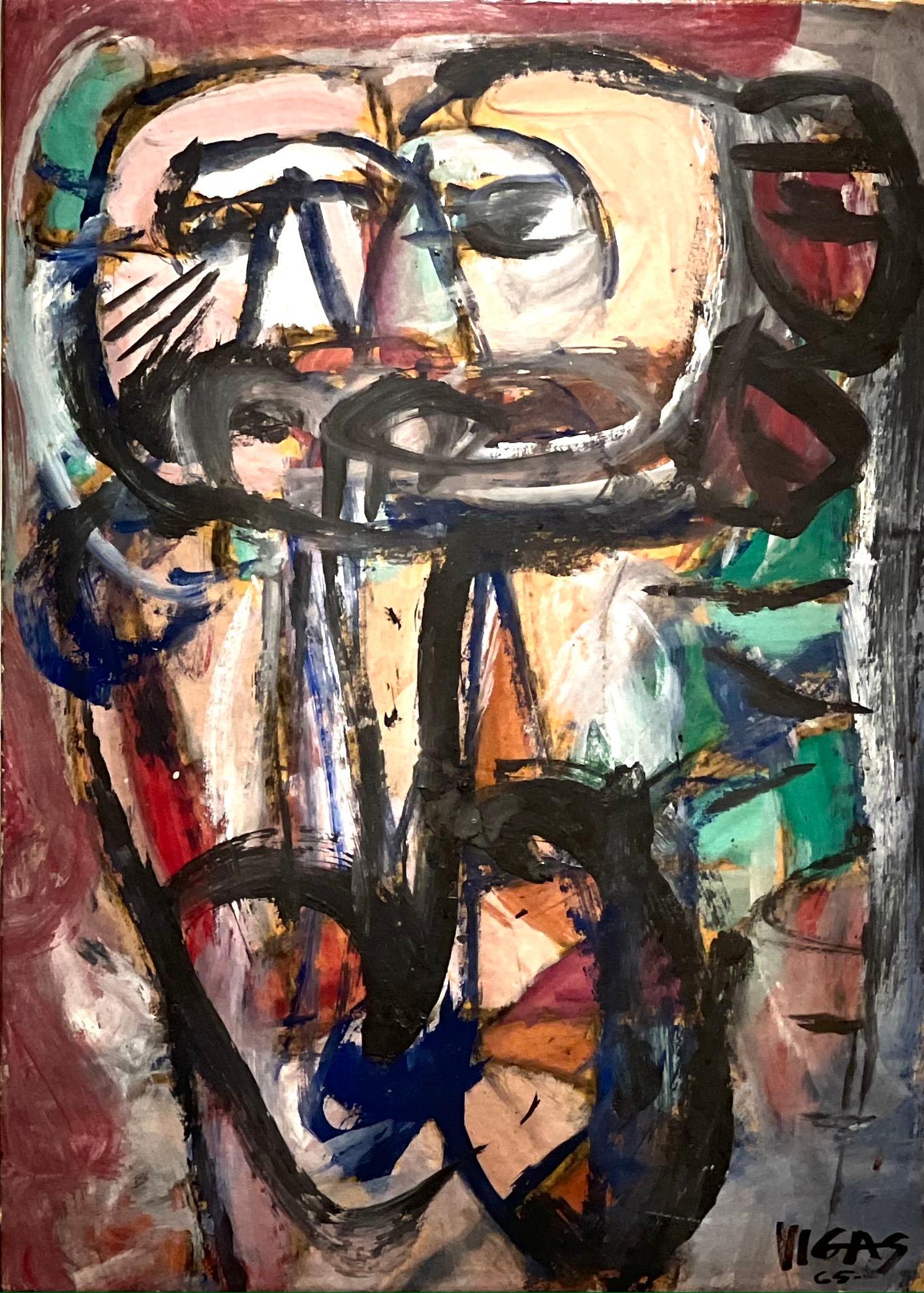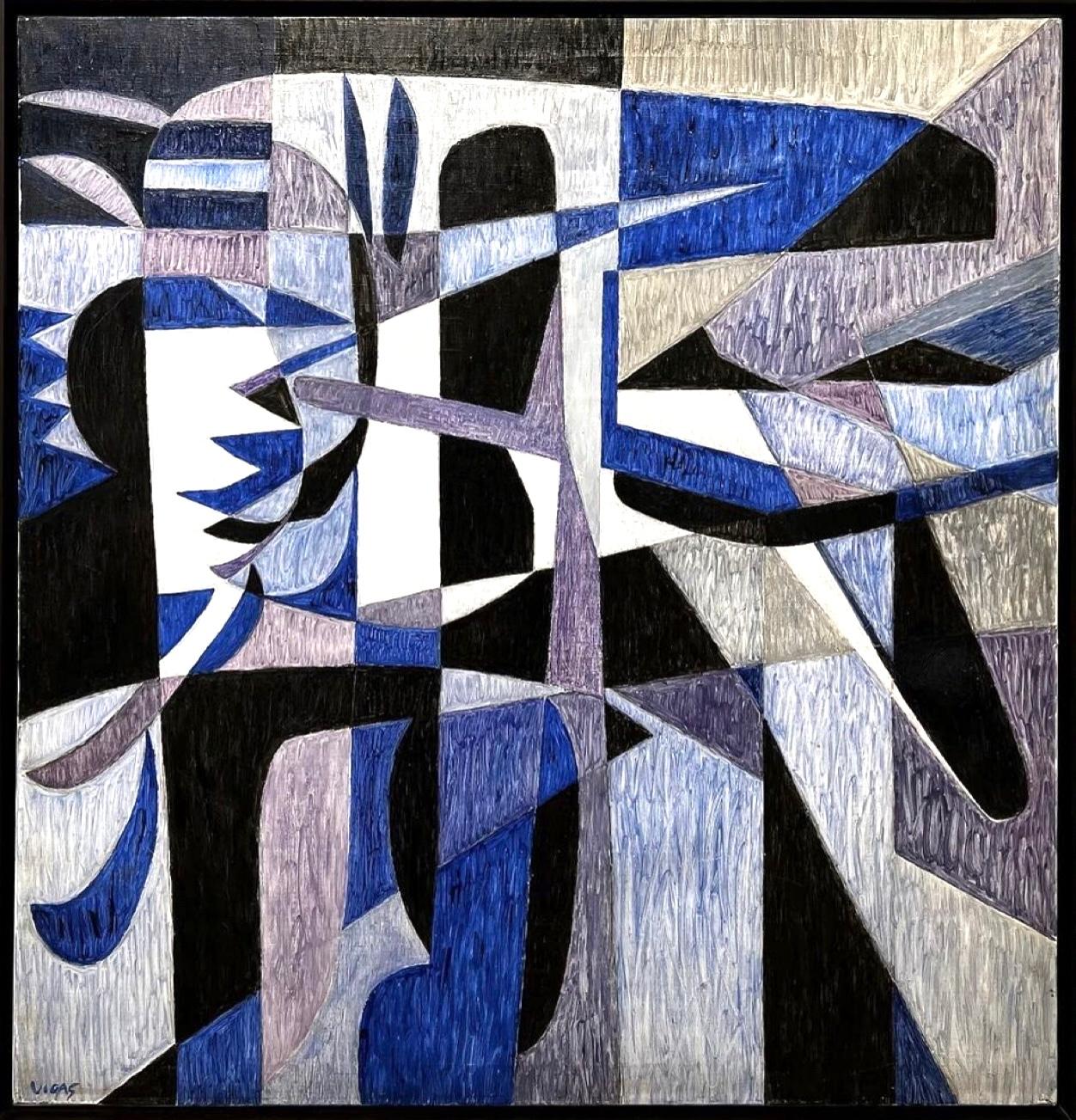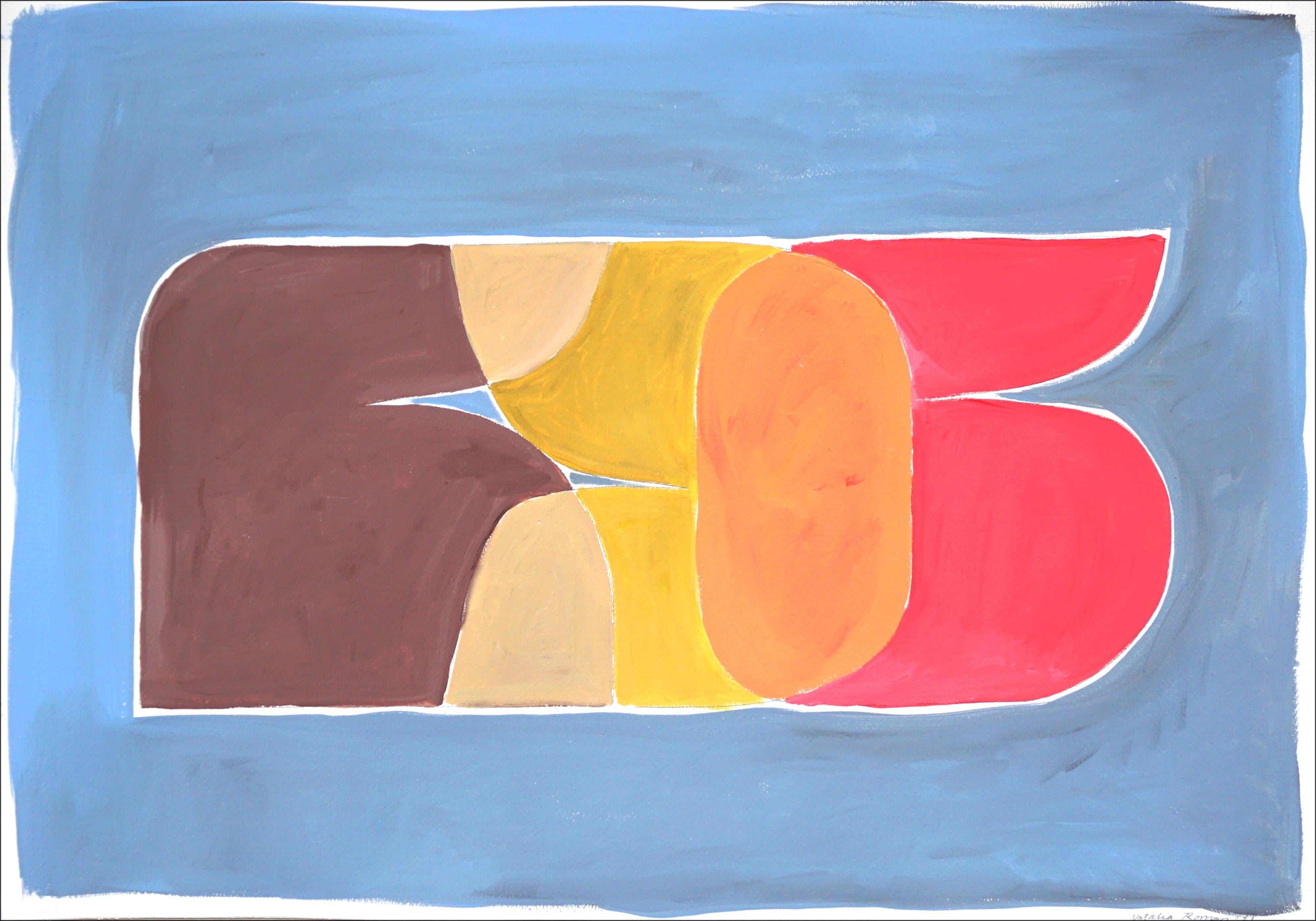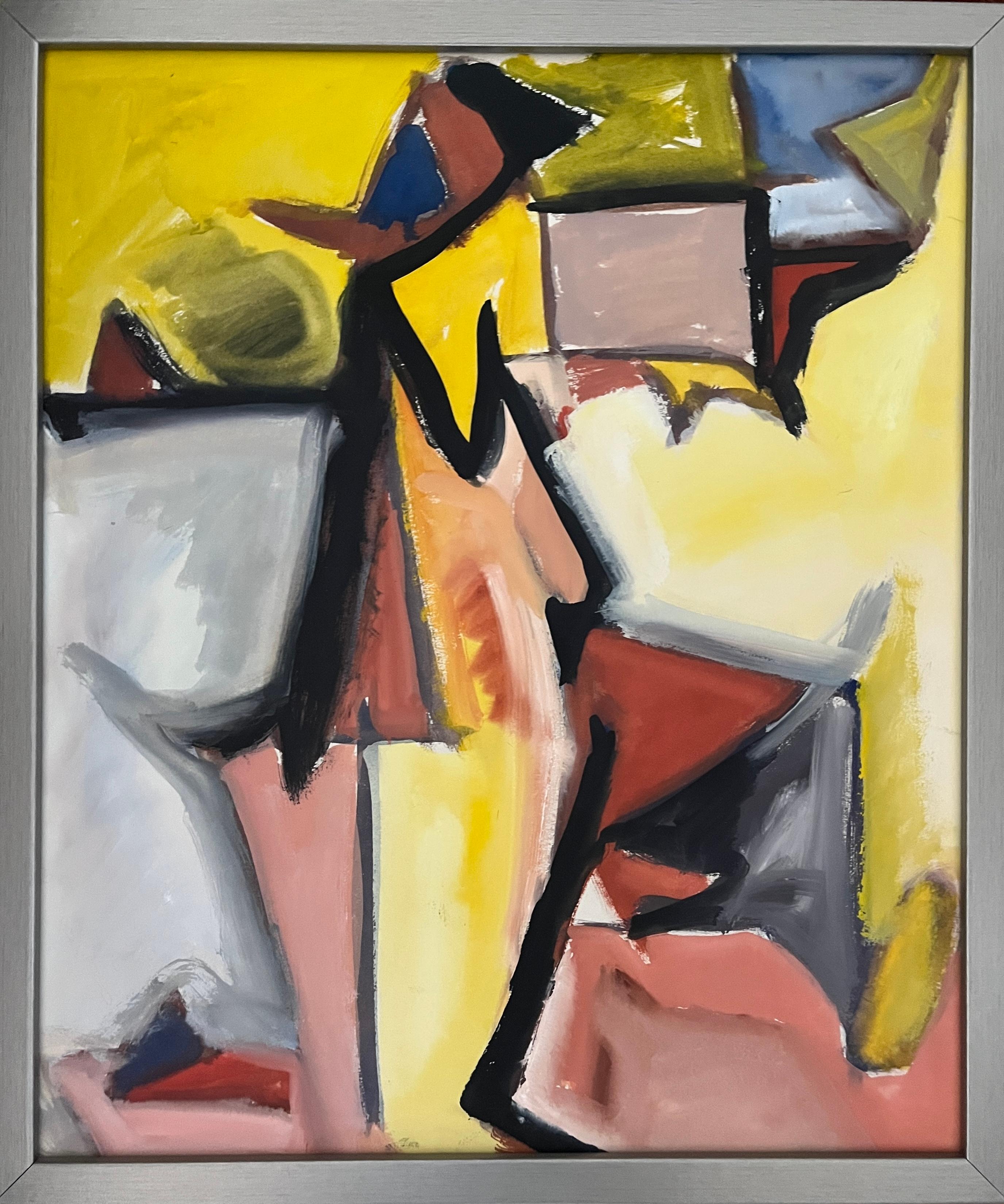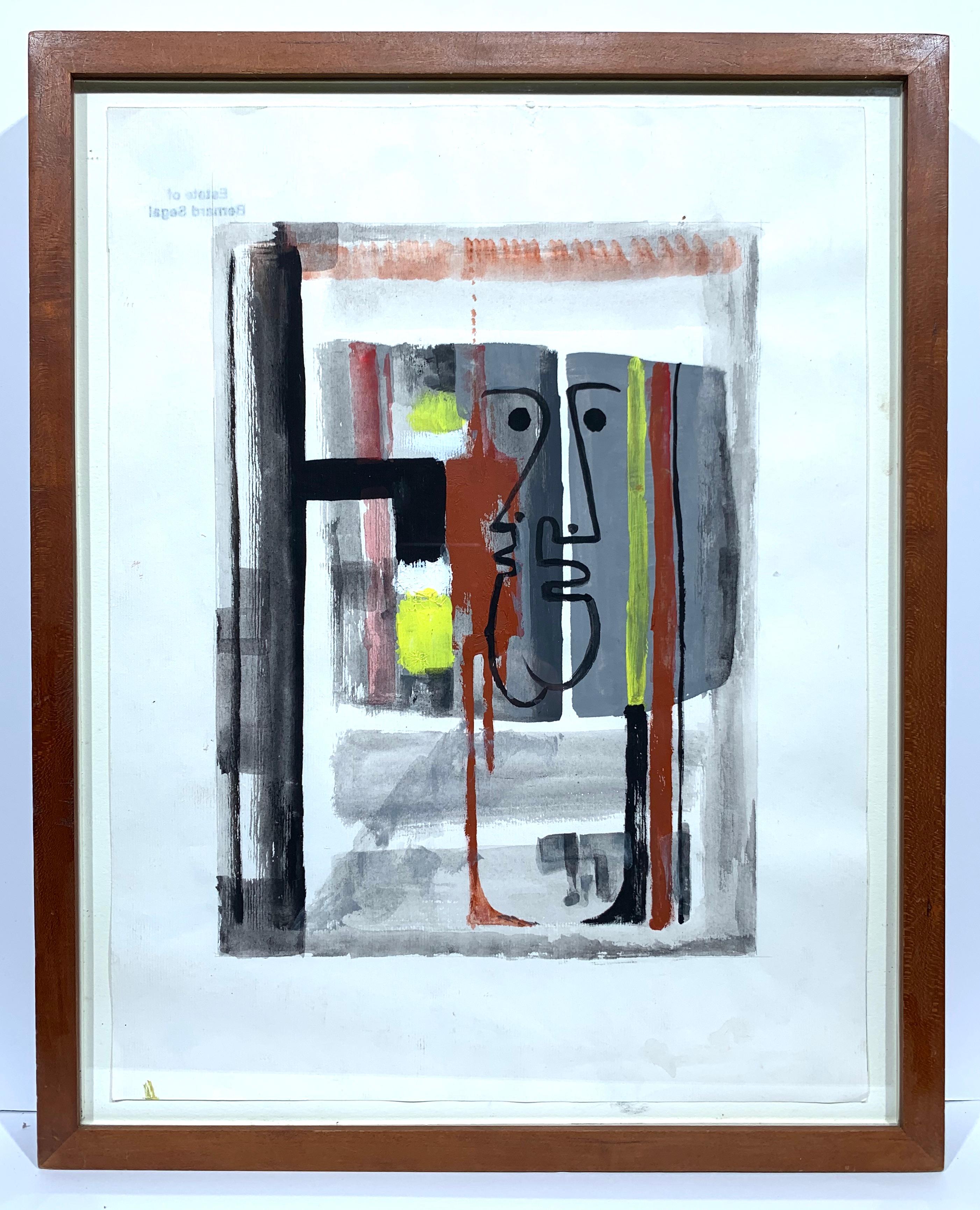Items Similar to Untitled
Want more images or videos?
Request additional images or videos from the seller
1 of 11
Leon KellyUntitled1922
1922
About the Item
Untitled Cubist Abstraction
Signed and dated lower right
Watercolor, charcoal and gouache on paper, 1922
Provenance: Estate of the Artist
Schroeder, Romero & Shredder, New York
Exhibited: Francis Nauman, Leon Kelly: Draftsman Extraordinaire, New York, April 4 - May 23, 2014.
Sheet: 18 1/2 x 14 1/2";
Frame: 29 x 25"
Leon Kelly (From Wikipedia, the free encyclopedia)
Leon Kelly (October 21, 1901 – June 28, 1982) was an American artist born in Philadelphia, PA. He is most well known for his contributions to American Surrealism, but his work also encompassed styles such as Cubism, Social Realism, and Abstraction. Reclusive by nature, a character trait that became more exaggerated in the 1940s and later, Kelly's work reflects his determination not to be limited by the trends of his time. His large output of paintings is complemented by a prolific number of drawings that span his career of 50 years. Some of the collections where his work is represented are: The Metropolitan Museum in New York, The Whitney Museum of American Art, the Museum of Modern Art, the Philadelphia Museum of Art, and Boston Public Library.
Biography
Kelly was born in 1901 at home at 1533 Newkirk Street, Philadelphia, PA. He was the only child of Elizabeth (née Stevenson) and Pantaleon L. Kelly. The family resided in Philadelphia where Pantaleon and two of his cousins owned Kelly Brothers, a successful tailoring business. The prosperity of the firm enabled his father to purchase a 144-acre farm in Bucks County PA in 1902, which he named "Rural Retreat" It was here that Pantaleon took Leon to spend every weekend away from the pressures of business and from the disappointments in his failing marriage. Idyllic and peaceful memories of the farm stayed with Leon and embued his work with a love of nature that emerged later in the Lunar Series, in Return and Departure, and in the insect imagery of his Surrealist work. "If anything," he once said,"I am a Pantheist and see a spirit in everything, the grass, the rocks, everything."
At thirteen, Leon left school and began private painting lessons with Albert Jean Adolphe, a teacher at the School of Industrial Art (now the University of the Arts) in Philadelphia. He learned technique by copying the works of the old masters and visiting the Philadelphia Zoo, where he would draw animals. Drawings done in 1916 and 1917 of elephants, snakes and antelope, as well as copies of old master paintings by Holbein and Michelangelo, heralded an impressive emerging talent. In 1917, he studied sculpture with Alexander Portnoff but his studies came to an abrupt halt with the start of World War I. Being too young to enlist, he joined the Quartermaster Corp at the Army Depot in Philadelphia, where he served for more than a year loading ships with supplies and, along with other artists, working on drawings for camouflage.
By 1920, the family's fortunes drastically changed. His father's business had failed due to the introduction of ready made clothing and his marriage, unhappy from the beginning, dissolved. Broken by circumstance Pantaleon left Philadelphia to begin a wandering existence looking for work leaving Leon to support his mother and grandmother. He found a job in 1920 at the Freihofer Baking Company where he worked nights for the next four years. Under these circumstances Leon continued to develop his skills in drawing and painting and learned of the revolutionary developments in art that were taking place in Paris.
During the day he was granted permission to study anatomy at the Philadelphia School of Osteopathy where he dissected a cadaver and perfected his knowledge of the human figure. He also met and studied etching with Earl Horter, a well known illustrator, who had amassed a significant collection of modern art which included work by Brancusi, Matisse, and Cubist works by Picasso and Braque. Among the artists around Horter was Arthur Carles, a charismatic and controversial painter who taught at the Pennsylvania Academy of Fine Arts. Leon enrolled in the Academy in 1922, becoming what Carles described as, "his best student".
In the next three years Leon work ranged from academic studies of plaster casts, to pointillism, to landscapes of Fairmount Park in Philadelphia, as well as a series of pastels showing influences from Matisse to Picasso. Clearly influenced by Earl Horter's collection and Arthur Carles he mastered analytical cubism in works such as The Three Pears, 1923 and 1925 experimented with Purism in Moon Behind the Italian House. In 1925 Kelly was awarded a Cresson Scholarship and on June 14 he left for Europe.
Paris
The first trip to Europe lasted for approximately three and a half months and introduced Kelly to a culture and place where he felt he belonged. Though he returned to the Academy in the Fall, he left for Europe again a few months later to begin a four-year stay in Paris. He moved into an apartment at 19 rue Daguerre in Paris and began an existence intellectually rich but in creature comforts, very poor. "I kept a cinderblock over the drain in the kitchen sink to keep the rats out of the apartment" he once explained. He frequented the cafes making acquaintances with Henry Miller, James Joyce and the critic Félix Fénéon as well as others. His days were split between copying old master paintings in the Louvre and pursuing modernist ideas that were swirling through the work of all the artists around him. The Lake, 1926 and Interior of the Studio, 1927, now in the Newark Museum.
Patrons during this time were the police official Leon Zamaran, a collector of Courbets, Lautrecs and others, who began collecting Kelly's work. Another was Alfred Barnes of the Barnes Collection in Philadelphia.
In 1929 Kelly married a young French woman, Henriette D'Erfurth. She appears frequently in paintings and drawings done between 1928 and the early 1930s.
Philadelphia
The stock market crash of 1929 made it impossible to continue living in Paris and Kelly and Henriette returned to Philadelphia in 1930. He rented a studio on Thompson Street and began working and participating in shows in the city's galleries. Work from 1930 to 1940 showed continuing influences and experimentation with the themes and techniques acquired in Paris as well as a brief foray into Social Realism. The Little Gallery of Contemporary Art purchased the Absinthe Drinker in 1931 and in 1932 exhibited Judgement of Paris, 1932, an ambitious painting with a classical theme. In October 1934, "Interior of a Slaughter House" and several other works were included in "Second Regional Exhibition of Painting and Prints by Philadelphia Artists" at the Whitney Museum in New York.
Kelly joined the Philadelphia Public Works of Art Project and worked on sketches for a mural destined for the School Administration Building. While some sketches survived, one is in the Metropolitan, the mural is lost. The harsh financial conditions of Kelly's life continued and by the late 1930s, Henriette, who spoke no English and whose only companionship outside the home was Helen Lloyd Horter (who spoke French), returned to France permanently When his divorce was finalized, Kelly began seeing Helen Lloyd Horter, a Philadelphia painter and a fellow student at the Academy and who was now the ex-wife of Earl Horter. In 1941 they married.
Kelly continued to work in his studio on Brandywine Street in Philadelphia teaching small classes to gain some income. Kelly's study of the masters in the Louvre collection resulted in great admiration for the Renaissance painter Leonardo Da Vinci. His influence is evident in Kelly's notebooks of this time which are full of drawings for World War II battlements and weaponry which echo DaVinci's drawings for the mechanisms of war. He also shared Leonardo's fascination with science and the underlying dynamics of how things work. His interest of the nervous system and sensory aspects of human anatomy would later come important components of his abstract figures of the 1950s and '60s.
- Creator:Leon Kelly (1901-1982, American)
- Creation Year:1922
- Dimensions:Height: 29 in (73.66 cm)Width: 25 in (63.5 cm)
- Medium:
- Movement & Style:
- Period:
- Condition:Framed with Conservation Clear Acrylic.
- Gallery Location:Fairlawn, OH
- Reference Number:
Leon Kelly
Leon Kelly, born in 1901, studied at the Pennsylvania Academy of the Fine Arts, Philadelphia. Awarded a traveling scholarship from that institution in 1924, he studied in Paris, France at the Grande Chaumiere. Other teachers included Arthur B. Carles, Jean Auguste Adolphe, Earl Horter and Alexandre Portinoff. Essentially a Surrealist painter, Kelly did wide-ranging work that went from painterly to meticulous Surrealism, Cezanne-inspired watercolors, and Cubist painting. In the 1940s, Julian Levy, the Surrealist dealer, handled Kelly's work in New York City. Kelly also exhibited at the Pennsylvania Academy of the Fine Art Annuals (1933-34, 1939-46, 1966); Corcoran Gallery Biennials, Washington, D.C. (three times from 1935-47); Art Institute of Chicago, Illinois; had a 1965 retrospective exhibition at the International Gallery, Baltimore, Maryland; Long Beach, New Jersey (1968); Richard Feigen Gallery, Chicago, Illinois (1968, 1970); Newark Museum, New Jersey (1969); and the Whitney Museum of American Art, New York. Kelly's paintings are in the collections of three New York city museums, including the Metropolitan Museum of Art; Whitney Museum of American Art; and Museum of Modern Art; as well as Yale University Art Gallery, New Haven, Connecticut; Wadsworth Atheneum, Hartford, Connecticut; Pennsylvania Academy of the Fine Arts, Philadelphia; Cantor Arts Center, Stanford University, Palo Alto, California; Sara Roby Foundation Collection at the Smithsonian Institution, Washington, D.C.; Smith College Museum of Art, Northampton, Massachusetts; Sheldon Memorial Art Gallery, Lincoln, Nebraska; Newark Museum, New Jersey; and the Tel Aviv Museum, Israel.
About the Seller
5.0
Recognized Seller
These prestigious sellers are industry leaders and represent the highest echelon for item quality and design.
Platinum Seller
These expertly vetted sellers are 1stDibs' most experienced sellers and are rated highest by our customers.
Established in 1978
1stDibs seller since 2013
713 sales on 1stDibs
Typical response time: 1 hour
Associations
International Fine Print Dealers Association
- ShippingRetrieving quote...Ships From: Fairlawn, OH
- Return PolicyA return for this item may be initiated within 10 days of delivery.
More From This SellerView All
- Untitled (six vignettes)By Pierre CourtinLocated in Fairlawn, OHSigned lower center edge Annotated verso: “5 Juin 1966 _____ et de soleil, de et d’oseille” Image: 6 3/4 x 4 5/8" Frame: 14 1/2 x 12 3/4" Finishe...Category
1960s Abstract Abstract Drawings and Watercolors
MaterialsWatercolor, Gouache
- (Untitled) Fabric DesignBy Marguerite GrossLocated in Fairlawn, OHUntitled (Fabric Design) Annotated on the verso with the studio address of the artist Signed in ink lower right corner: “Marguerite Gross” Gouache on heavy paper, 1930-1939 In 1930 ...Category
1930s Abstract Abstract Paintings
MaterialsGouache
- UntitledBy Dennis AshbaughLocated in Fairlawn, OHUntitled Mixed media on paper, 1981 Signed and dated 1981 lower left (see photo) Provenance: Knoedler Gallery, New York (label) Charles Cowles Gallery, New York The Collection of Jan...Category
1980s Abstract Abstract Paintings
MaterialsMixed Media, Gouache
- Fabric Design (Black and White)By Lizzie DerrieyLocated in Fairlawn, OHUnsigned as is usual References: Located at 136, rue du Faubourg Saint-Honoré, the Lizzie Derriey Design Studio was active from 1928-1994. This creative co-operative, which emp...Category
20th Century Abstract Paintings
MaterialsGouache
- Arctic Light - Orange SunBy Karl ZerbeLocated in Fairlawn, OHArctic Light-Orange Sun Unsigned Gouache on Japanese fibrous paper Series: Tundra Paintings Exhibited: Karl Zerbe, Gouaches of the Artic Nordness Gallery, (Madison Avenue, NY) Feb 3 through Feb 23, 1958 Cat. No. 12 (label with work, see photo...Category
1950s American Modern Abstract Paintings
MaterialsGouache
- Handel Organ Concerto Opus No. 4 B Flat Major - III AllegroBy Hildegarde HaasLocated in Fairlawn, OHHandel Organ Concerto Opus 4 No.6 B Flat Major - III Allegro Watercolor and mixed pigments on paper, c. 1960's Signed and titled recto (see photos) Condition: Excellent Image: 19 3/4...Category
1960s Abstract Abstract Paintings
MaterialsWatercolor
You May Also Like
- Untitled, 1965By Oswaldo VigasLocated in Palm Beach, FLPredominantly recognized as a self-taught painter, he also worked in architectural murals, sculptures, ceramics, prints and drawings. Vigas is one...Category
1960s Cubist Figurative Paintings
MaterialsCanvas, Oil, Gouache, Board
- BelisamaBy Oswaldo VigasLocated in Palm Beach, FLPredominantly recognized as a self-taught painter, he also worked in architectural murals, sculptures, ceramics, prints and drawings. Vigas is one...Category
1960s Cubist Figurative Paintings
MaterialsCanvas, Oil, Gouache, Board
- Abstracted Letter Sunset, Vintage Miami Style Colors, Earth Tones FiguresBy Natalia RomanLocated in Barcelona, ES"Abstracted Letter Sunset" is an abstract painting by Spanish artist Natalia Roman. These color field paintings are inspired by both modernist shapes of ...Category
2010s Cubist Abstract Paintings
MaterialsOil Pastel, Oil, Acrylic, Watercolor, Gouache
- Russian School Art Deco Cubist Gouache on Board PaintingLocated in Atlanta, GAA stunning Art Deco cubist gouache on cardboard painting from a Russian Artist in Paris (20th Century). The artwork shows no visible signature. This is a typical example of the Russi...Category
20th Century Cubist Abstract Paintings
MaterialsGouache, Board, Cardboard
- 1950s "Yellow Cubist Figure" Abstract Figurative PaintingLocated in Arp, TXFrom the estate of Jerry Opper & Ruth Friedmann Opper Yellow Cubist FIgure c. 1940-1950's Gouache 15" x 18", silver wood frame 16"x19" Unsigned This striking gouache painting featur...Category
1950s Cubist Abstract Paintings
MaterialsGouache
- Cubist portraitLocated in Wilton Manors, FLBernard Segal (1907-1986). Cubist portrait, ca. 1960. Gouache and watercolor on paper, sheet measures 10 x 13.5 inches; 12.25 x 15.25 inches framed. U...Category
Mid-20th Century Cubist Abstract Paintings
MaterialsPaper, Gouache
Recently Viewed
View AllMore Ways To Browse
With Supplies
Kelly 2
In And Out Kelly
Thompson Street
25 Kelly
Kelly 25
Revolutionary War Art
Picasso 1929
Modern Kitchen Painting
Abstract Charcoal Sketch
Charcoal Sketches Black
Large Kitchen Paintings
1930s Cubist Painting
Untitled 23
Kelly 18
Revolutionary War Paintings
Large Cubist Sculpture
1930s Industrial Painting
